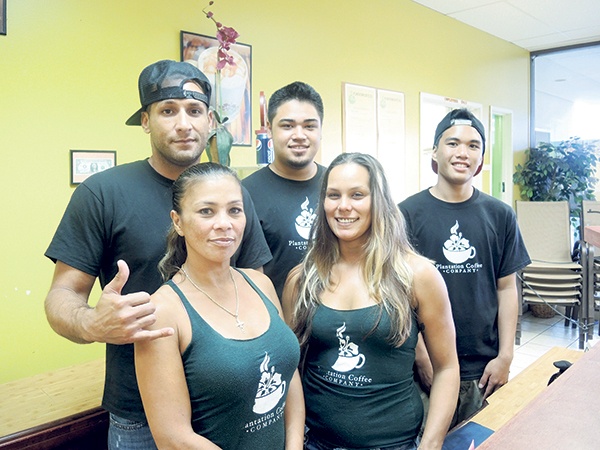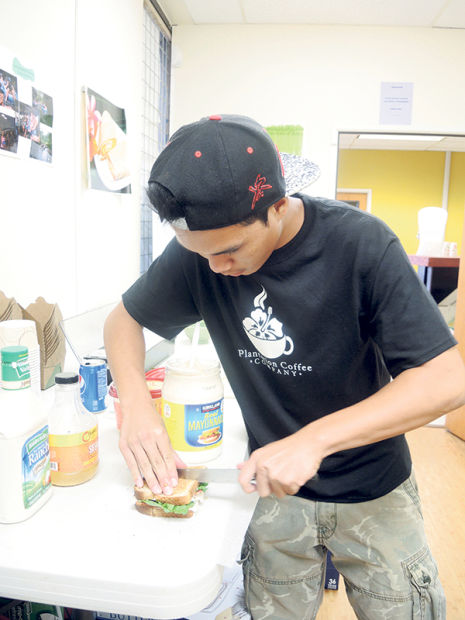LIHUE – Kris Kualii, assistant manager at Plantation Coffee Company, is a recovering addict. He knows what it’s like to need a fix. “I was headed for death,” Kualii said. The 35-year-old graduated from Kauai High School, but the boys
LIHUE – Kris Kualii, assistant manager at Plantation Coffee Company, is a recovering addict. He knows what it’s like to need a fix.
“I was headed for death,” Kualii said.
The 35-year-old graduated from Kauai High School, but the boys who now work for his business, didn’t.
Like Richard Cremer.
Cremer is a 16-year-old dropout from Kapaa. So is 17-year-old Caleb Abergas, from Kekaha. School wasn’t working for him, either.
“Most of their parents party and are addicted to drugs,” Kualii said about some of the teen high school dropouts he meets. “We help them to be on a better track then partying. We guide them toward being better adults.”
Kualii and Sheena Millare, the manager of Plantation Coffee Company, make it their business to help teens who leave school early.
“I wish I had someone like me at their age,” said Millare, who started using drugs at the age of 12 – specifically ice, a type of methamphetamine – for seven years. “Getting high made me feel good.”
She was arrested and went to jail, but turned her life around when the fear of going to jail again hung over her.
“I knew if I used again, I’d go back for 20 years,” she said.
She wants a better life for Cremer and Abergas and other high school dropouts who are committed to turning their lives around. The numbers say that Hawaii still has a number of dropouts, however. According to national statistics, Hawaii’s rate is declining, but is more than double the national average.
A recent Hawaii Department of Education report shows that Hawaii’s rate fell from 15.7 percent in 2010-11, to 15.1 percent in 2011-12 and 14.8 percent in 2012-13. In 2012, the national average was 7 percent.
On Kauai, the rates vary. Kapaa High School and Waimea High School have 13.6 percent and 12.4 percent dropout rates, respectively. Kauai High School sits at 5.9 percent for the 2012-13 school year.
Bill Arakaki, Kauai Complex Area Superintendent, said there could be a variety of reasons behind the dropout numbers. Students could leave public school for less traditional learning methods, for example.
“The, ‘Dropout Data,’ reflects students overall transiency per their original cohort group of students entering in the ninth grade,” he wrote in an email. “School data will vary due to the number of students selecting alternative options, i.e. home school, online learning, charter school, about face program, youth challenge and employment.”
Abergas is one who is finishing through an alternate route.
Abergas quit public school the summer before his senior year and is now studying to earn a competency based diploma during morning classes through Hale Kipa, a Kauai nonprofit managed in Lihue by Melinda Montgomery. After class, he walks across the hall to the Plantation Coffee Company to earn income and learn life skills. It’s his first job at a store with the purpose of making a difference in the lives of at-risk youth.
“I want to go to KCC culinary school,” Abergas said about the community college program.
Montgomery is aware that Hawaii’s dropout numbers are higher than most areas. She said she finds fulfillment in helping struggling youth, especially since she used to be one herself, after her mother passed away and she lived in foster homes.
She said she knows there are different reasons for students who leave school early. The key is righting the ship and finding a purpose once they do.
“I want them to rise above their history and their past experiences,” Montgomery said.
It was Montgomery’s idea to open the Plantation Coffee Company in the lobby of the Lihue Plantation Building. The location was ideal for her Hale Kipa students after they finished their morning studies.
“We get kids coming back from detention programs, kids on probation who don’t want to go to school, we get dropouts,” Montgomery said.
Stacey Gillette, Keiki to Career coordinator, said young students need a support system when they drop out of school.
“Students can’t do it alone, but neither can parents, schools or nonprofits,” Gillette said. “It takes everyone to get to the finish line.”
She pointed to the Hale Kipa program and work opportunities for youth at Plantation Coffee Company as good examples.
“This is a great example of what’s possible when we refuse to give up,” she said. “Together, anything is possible.”
Some studies show that high school dropouts can expect to earn 41 percent less than their graduating counterparts.
Cremer is grateful for the help. He was in the seventh grade when he dropped out of school and now he’s taking advantage of Montgomery’s program.
“I wanted to be at the beach every day and go surfing,” Cremer said. “I would pretend I was going to school and then go to Kalapaki Beach to surf and body board all day long. My goal was to be a pro surfer.”
All three of his older siblings dropped out of school, too.
Now, his advice to his 5-year-old brother is different than what it might have been before.
“I’d tell him how hard it is without an education,” he said.
•••
Lisa Ann Capozzi, a features and education reporter can be reached at lcapozzi@thegardenisland.com.



